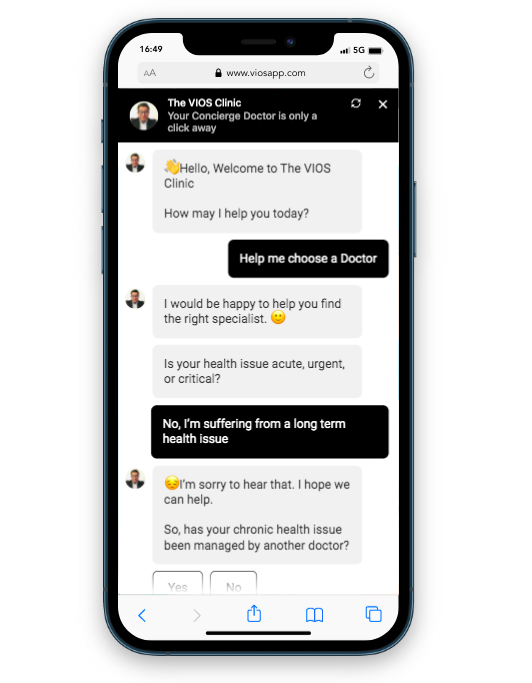Driving Healthcare Automation with Chatbots in 2023
In recent years, chatbots have become increasingly popular as a means of providing customer support. Concierge medicine is an area where chatbots can be particularly useful in assisting patients with scheduling appointments and answering general questions. In this beginner’s guide, we will explore how chatbots work and some tips for using them effectively in concierge medicine.
What are Chatbots used for?
Chatbots are computer programs that can mimic human conversation. chatbots can be used for a variety of purposes, such as customer service, marketing, and even healthcare.
One common use for chatbots is to provide customer service. chatbots can help customers with tasks such as finding information on a product or order products. chatbots can also help customers with more complicated issues, such as returns or refunds.

Chatbots are also commonly used for marketing purposes. chatbots can be used to gather information about customers, such as their preferences or what types of products they are interested in. chatbots can also be used to send customers promotional messages or discounts.
Chatbots can also be used in the healthcare industry. chatbots can be used to help patients book appointments or to provide information about medical conditions. chatbots can also be used to collect data about patients for research purposes.
Chatbots can be used for a variety of other purposes, such as education and training. chatbots can be used to help students learn new subjects or practice their English skills. chatbots can also be used to train employees on new products or procedures.
Chatbots are a versatile tool that can be used for a variety of purposes. They are a great way to provide customer service, promote products, and collect data.
Are chatbots better than a call center?
This is a question that has been debated by businesses and customers alike. There are pros and cons to both chatbots and call centers. Here, we will take a look at the advantages and disadvantages of each option to help you decide which is best for your business.
Advantages of chatbots:
– Chatbots are available 24/7, whereas call centers usually have limited hours.
– Chatbots can handle multiple chats at once, whereas call centers can only handle one call at a time.
– Chatbots do not require breaks and can work tirelessly, whereas call centers need to take regular breaks.
– Chatbots can provide automated customer support, whereas call center agents are human and may not always have the answer to a question.
Disadvantages of chatbots:
– Chatbots may not be able to understand complex customer queries, whereas call center agents are trained to deal with such queries.
– chatbots may not be able to show empathy like call center agents can.
– chatbots may come across as robotic and impersonal, whereas call center agents are human and can build a rapport with customers.
How can chatbots improve customer service?
There are many potential ways chatbots can improve customer service. For one, chatbots can help reduce the wait time for customers who need support. In call centers, chatbots can take on some of the more simple tasks, such as gathering information from customers or answering common questions.
This can help free up customer support agents to handle more complex issues.
Additionally, chatbots can provide a more personalized experience for customers, which can lead to higher satisfaction levels. By using chatbots, businesses can improve cu

How to use chatbots in healthcare
There are many ways chatbots can be used in healthcare, from providing general information to helping patients manage their care. Here are some examples of how chatbots can be used in healthcare:
- General information chatbots: These chatbots can provide general health information, such as answers to common questions about a particular condition or disease.
- Appointment scheduling chatbots: These chatbots can help patients schedule appointments with doctors or other healthcare providers.
- Care management chatbots: These chatbots can help patients manage their care, such as by providing reminders about taking medication or booking follow-up appointments.
- Symptom checker chatbots: These chatbots can help patients identify their symptoms and get guidance on whether they need to see a doctor or not.
- Diagnosis chatbots: These chatbots can provide patients with a diagnosis based on their symptoms.
- Treatment chatbots: These chatbots can provide patients with information about treatment options and how to follow their treatment plans.
- Emergency chatbots: These chatbots can help patients in an emergency situation, such as by providing them with the nearest hospital or telling them what to do if they have a heart attack.
- Mental health chatbots: These chatbots can help patients with mental health conditions, such as anxiety or depression.

Tips for using chatbots in healthcare:
- Make sure the chatbot you choose is HIPAA-compliant. This means that it meets all of the privacy regulations set by the US Department of Health and Human Services.
- Choose a chatbot that is appropriate for the task you want it to perform. If you just want general information, a chatbot with basic capabilities will suffice. However, if you need specific advice or support, choose a chatbot that has been designed for healthcare.
- Be clear about what you want the chatbot to do. When you first start using a chatbot, it can be helpful to give it very specific commands so that it knows what you expect from it. For example, tell the chatbot to “find a doctor in my area” or “book an appointment with my primary care physician.”
- Be patient with the chatbot. It may take some time for the chatbot to understand your questions and provide the information you need. Don’t be afraid to ask the chatbot to repeat itself or explain something in more detail.
- Be prepared to answer the chatbot’s questions. Many chatbots will ask you a series of questions in order to get to know you better. These questions may include your age, gender, and health history. Be honest when answering these questions, as the chatbot will use the information you provide to provide better support.
- Use the chatbot for educational purposes. Chatbots can be a great way to learn more about your health and how to take care of yourself. Ask the chatbot any question you have about your health, and it will do its best to provide you with an answer.
- Report any problems you have with the chatbot. If the chatbot isn’t providing the support you need, or if you’re having trouble understanding what it’s saying, let your healthcare provider know. They may be able to recommend a different chatbot that is more suitable for your needs.
How to use chatbots for triage
Healthcare chatbots are currently being used by healthcare providers to triage patients. By asking a series of questions, chatbots can help determine the severity of a patient’s condition and provide them with the appropriate level of care. This can help reduce wait times and ensure that patients receive the care they need as quickly as possible. chatbots can also be used to collect data about patients’ conditions, which can be used to improve healthcare services overall.
There is no one-size-fits-all answer to this question, as the best chatbot for triage will vary depending on the specific needs of the healthcare organization. However, there are some general tips that can be followed when choosing and using a chatbot for triage.
First, it is important to choose a chatbot that has been specifically designed for healthcare applications. This will ensure that the chatbot is equipped with the necessary knowledge and tools to provide accurate and helpful information.
Second, the chatbot should be able to easily integrate with existing healthcare systems and databases. This will allow the chatbot to access important patient information and make recommendations based on that data.
Third, the chatbot should be able to handle a variety of different tasks related to triage. This could include answering general questions about symptoms, providing information about treatment options, and even scheduling appointments.
Finally, it is important to test the chatbot before using it with patients. This will help to ensure that the chatbot is functioning properly and providing accurate and helpful information.
Healthcare chatbots offer a number of potential benefits for healthcare organizations, including increased efficiency and accuracy in triage. By following the tips above, healthcare organizations can choose and use chatbots to improve patient care.

Why chatbots are important in telemedicine
The chatbot industry is booming. The market for chatbots is expected to grow from $2.3 billion in 2017 to $7.5 billion by 2021, according to a report by MarketsandMarkets. This growth is being driven by the increasing demand for chatbots across all industries, including healthcare.
One of the most promising applications of chatbots in healthcare is their use in telemedicine. Telemedicine is the delivery of medical care remotely, using technology such as video conferencing or email. It can be used to provide primary care to patients who live in remote areas or to provide specialist care to patients who are unable to travel for treatment.
Chatbots offer several advantages over traditional telemedicine methods such as video conferencing. They are cheaper, faster, and easier to use. They also offer the potential for increased patient engagement and improved patient outcomes.
Healthcare chatbots can be used to provide a variety of telemedicine services, including:
– Consultations with doctors or other healthcare professionals
– Diagnosis and treatment of medical conditions
– Prescription of medications
– Monitoring of patients’ health status
The use of chatbots in telemedicine is still in its early stages, but it is clear that they have great potential for improving the delivery of healthcare services. For example, chatbots could be used to provide primary care to patients in remote areas or to improve access to specialist care for patients who are unable to travel for treatment.
In the future, chatbots could become an essential part of the telemedicine landscape, providing a convenient and affordable way for patients to access healthcare services.

Will Chatbots replace healthcare workers?
The healthcare industry is rapidly changing and chatbots are becoming increasingly popular. So the question remains, will chatbots eventually replace healthcare workers?
There are many advantages to chatbots, such as 24/7 availability, quick responses, and low costs. However, chatbots also have limitations, such as not being able to provide personalized care or make complex decisions.
Healthcare workers play a vital role in our society and will continue to do so even as chatbots become more prevalent. Chatbots can help to supplement the work of healthcare workers, but they will never be able to replace them entirely. doctors and healthcare workers provide critical care and support to patients, and chatbots cannot replicate the human touch that is so important in healthcare.
Chatbots will continue to evolve and become more sophisticated, but they will never be able to completely replace healthcare workers. At this point, chatbots are best used for tasks such as scheduling appointments or providing basic information. Healthcare workers will continue to be an essential part of the healthcare industry, and their skills and expertise will always be needed.

Can chatbots be HIPAA-compliant?
Yes, chatbots can be HIPAA-compliant. In order to be compliant, chatbots must adhere to the same privacy and security rules as any other type of health information technology. This includes ensuring that chatbots protect the confidentiality, integrity, and availability of PHI. chatbots must also allow patients to access their own PHI, and chatbots must comply with HIPAA’s requirements for audit and accountability.
The Health Insurance Portability and Accountability Act of 1996 (HIPAA) is a United States federal law that regulates the privacy and security of electronic health information. chatbots that collect, store, or transmit protected health information (PHI) must be HIPAA-compliant.
There are several requirements that chatbots must meet in order to be HIPAA-compliant.
First, chatbot operators must take steps to protect the privacy and security of PHI. This includes ensuring that chatbot conversations are encrypted and that chatbot users have a unique login and password.
Second, chatbots must have a way to allow patients to access their own PHI. This can be done through a patient portal or by providing patients with a download link for their PHI.
Third, chatbots must have a way to ensure that only authorized individuals have access to PHI. This includes implementing authentication measures, such as two-factor authentication, and having a process in place for revoking access to PHI if necessary.
Fourth, chatbots must maintain logs of all chatbot conversations that involve PHI. These logs must include the date and time of each conversation, the identity of the chatbot user, and the contents of the conversation.
Healthcare hatbots that meet these requirements can be HIPAA-compliant. However, chatbot operators should consult with a healthcare lawyer to ensure that their chatbot meets all of the requirements of HIPAA.
When can you use chatbots without HIPAA?
HIPAA compliance is important for chatbot developers to keep in mind, as chatbots are becoming increasingly popular and are likely to be used in more healthcare settings in the future. By understanding HIPAA’s requirements and implementing the appropriate safeguards, chatbot developers can help ensure that their chatbots are compliant with the law and protect the privacy of patients’ data when required.
There are a few scenarios where chatbots can be used without running into any HIPAA compliance issues. For example, chatbots can be used for general customer service inquiries, providing product recommendations, or giving weather updates.
As long as the chatbot is not handling any sensitive personal information, there should be no problem using it in these scenarios. chatbots can also be used in non-clinical settings such as human resources or marketing. chatbots are only subject to HIPAA compliance when they are handling protected health information (PHI).
When chatbots are not handling PHI, they are not considered “covered entities” under HIPAA and therefore are not subject to its rules and regulations. chatbots can still be used in healthcare settings, but they must follow all HIPAA guidelines when doing so.
This means that chatbots must have appropriate security measures in place to protect PHI, and they must only collect the minimum amount of PHI necessary to perform their intended function. Healthcare chatbots that do not comply with HIPAA may be subject to fines and other penalties.

Will patients actually interact with a Chatbot?
This will depend on the chatbot in question and the patient’s preferences. Some chatbots are designed purely for providing information, while others are interactive and allow patients to communicate with a healthcare professional.
Ultimately, it will be up to the patient to decide whether they feel comfortable interacting with a chatbot. However, chatbots can be a valuable tool for patients who want to get more information about their health or who need help communicating with their healthcare provider.
Chatbots have the potential to improve patient communication and engagement in a number of ways. They can provide patients with information about their health condition, help them connect with their care team, and provide educational materials. In addition, chatbots can be used to schedule appointments and send reminders for medication schedules and appointments.
Patients are more likely to use chatbots if they are easy to use and convenient. Therefore, chatbot developers should focus on creating chatbots that are user-friendly and easy to navigate.
What services can a chatbot provide to patients?
There are many services that chatbots can provide to patients. Here are some of the most common ones:
– providing patient education
– tracking medications
– providing support for mental health issues
– providing appointment reminders
– helping patients find doctors and other medical professionals
– providing information about insurance coverage and healthcare costs
– helping patients submit insurance claims and appeal denials
– providing information about specific diseases or conditions.
How will you measure the success of your chatbot?
Chatbots are a new technology that is becoming more and more popular. As businesses begin to adopt chatbots, it is important to measure their success in order to determine whether or not chatbots are the right solution for your business. There are a few ways to measure the success of a chatbot:
ENGAGEMENT
Measuring how many people are interacting with your chatbot is a good way to gauge its success. You can track how many messages your chatbot sends and receives, as well as how long users are spending on average in conversation with the chatbot.
CUSTOMER SATISFACTION
Another way to measure success is by looking at customer satisfaction ratings. You can ask customers to rate their experience with the chatbot on a scale of 1 to 10, and see if there is any improvement after deploying the chatbot.
BUSINESS OUTCOMES
Ultimately, you want to see how the chatbot is impacting your business. You can track things like conversion rates, customer acquisition costs, and customer retention rates to see if the chatbot is helping to improve your bottom line.
Measuring the success of a chatbot can be tricky, but it’s important to do in order to determine whether or not chatbots are the right solution for your business. By tracking engagement rates, customer satisfaction ratings, and business outcomes, you can get a good idea of whether or not your chatbot is successful.
Can chatbots provide concierge-style support?
Yes, and no.
Most chhatbots can provide a variety of support options, but the level of concierge-style service that they offer will depend on the chatbot and the specific situation. Some chatbots are quite limited in what they can do, while others are more robust and can provide a wide range of services.
In general, chatbots are most useful for providing customer support or concierge-style assistance for simple tasks such as booking appointments or ordering products. If you need more complex assistance, then a chatbot may not be able to provide the level of service you need.
However, chatbots are constantly evolving and becoming more sophisticated, so it is possible that they may eventually offer a wider range of concierge-style services.
Why did The VIOS Clinic install a Chatbot?
There are many reasons why The VIOS Clinic decided to install a chatbot. One of the primary reasons is that concierge medicine is all about providing convenient, personalized care to patients. Chatbots are a great way to provide this type of care, as they can help schedule appointments, answer questions, and even provide reminders.
Another reason chatbots are so beneficial is that they can help reduce the number of phone calls made to clinics. This can free up time for staff members who can then focus on providing more direct patient care. In addition, chatbots can also help reduce the amount of time patients spend on hold when trying to reach a clinic.

Additionally, chatbots can help improve patient satisfaction by providing quick and easy access to information and care. Patients who can easily get the answers they need are more likely to be satisfied with their overall experience. Chatbots provide a convenient way for patients to get the care they need when they need it.
The VIOS Clinic is committed to providing the best possible care to our patients. That’s why we decided to install a chatbot. With its many benefits, a chatbot is a great way to provide convenient, personalized care. So if you have any questions, or need help scheduling an appointment, be sure to ask our chatbot!

Conclusion
The potential for chatbots in the healthcare industry is huge. They have the ability to improve communication between patients and doctors, provide better customer service, and upgrade the efficiency of medical centers of any size. We’ve seen just a glimpse of what chatbots can do in this industry. If you want to try out our chatbot for yourself, visit our website and find a doctor for your health needs today.
BLOG AUTHOR
Dr. Ismail Sayeed
Dr. Sayeed is the Medical Director of ViOS, Inc. He is a deeply committed physician entrepreneur & medical blog writer. While building the global infrastructure of the VIOS Clinic, he is dedicated to educate people on the potential of specialist telemedicine for managing chronic diseases.
Read more about him in his author bio

